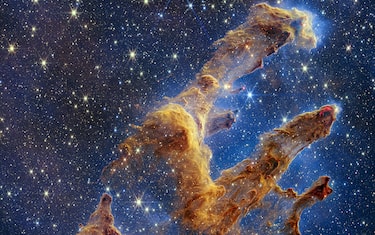L'immagine è stata condivisa sull'account Twitter Sun della Nasa. Il "sorriso" della nostra stella è formato dai buchi coronali, macchie correlate alle linee del campo magnetico solare
Un "sorriso" inaspettato del Sole è stato immortalato dal telescopio spaziale Solar Dynamics Observatory (Sdo) della Nasa. La foto è stata postata dall'Agenzia su Twitter, e mostra tre macchie comparse recentemente sulla nostra stella che, per una felice coincidenza hanno assunto le sembianze di due occhi e di una bocca sorridente. Le macchie scure sono in realtà buchi che si formano periodicamente nella parte più esterna dell'atmosfera del Sole, chiamata corona solare, in zone più fredde e in cui il plasma è meno denso, e da dove veloci raffiche di particelle elettricamente cariche (vento solare) vengono emesse nello spazio.
Cosa sono i buchi coronali del Sole
I cosiddetti buchi coronali sono stati scoperti quando i telescopi a raggi x della missione Skylab furono inviati oltre l'atmosfera terrestre per osservare la nostra stella. Questi buchi sono correlati alle linee del campo magnetico solare: durante il periodo di minore attività del Sole si trovano principalmente nelle regioni polari, mentre quando la stella è più attiva compaiono molte macchie sparse su tutta la superficie.

approfondimento
Missione Minerva, i 170 giorni nello spazio di Samantha Cristoforetti
La foto scattata dal telescopio spaziale Sdo
L'attuale ciclo solare sta mostrando un'attività insolitamente elevata, tanto che il raggiungimento del picco massimo, inizialmente previsto per il 2025, arriverà probabilmente in anticipo di un anno. Proprio un esempio di questa attività sono i buchi coronali ora fotografati dal telescopio spaziale Sdo, lanciato nel 2010 e che orbita a circa 36mila chilometri dalla Terra. Ma c'è chi ha visto nella particolare disposizione delle macchie qualcosa di più di una faccia sorridente: secondo alcuni utenti di Twitter, infatti, la somiglianza è notevole anche con uno dei cattivi di Ghostbusters, l'enorme pupazzo bianco vestito da marinaio noto come 'l'uomo della pubblicità dei marshmallow'.


)
)
)
)
)